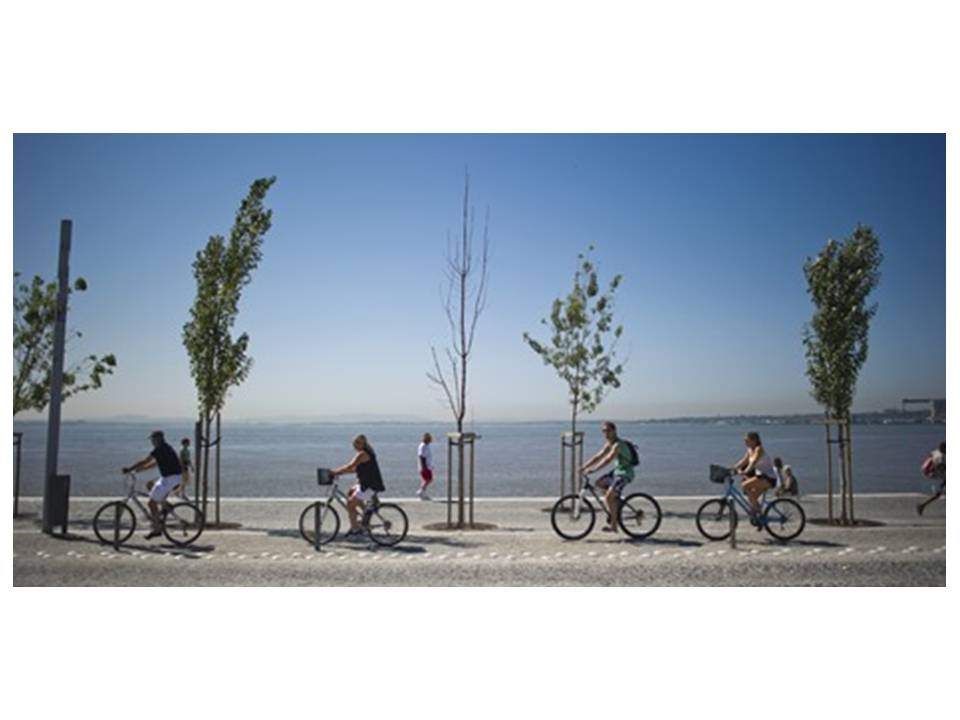
Portugal, Europe's next cycling nation? - blog post by B. C. Pereira
 Bernardo Campos Pereira - a Portuguese architect and bicycle mobility planning and policy expert. Mr. Pereira in this blog post shares the best practice examples from Portugal, demonstrating the increasing popularity of cycling in this country.
Bernardo Campos Pereira - a Portuguese architect and bicycle mobility planning and policy expert. Mr. Pereira in this blog post shares the best practice examples from Portugal, demonstrating the increasing popularity of cycling in this country.
At a first glance Portugal is not an obvious choice for a bicycle nation. But that's only at a first, very superficial glance. Look at what's going on right now, and decide for yourself...

In 1950, bicycle use in Portugal had a mode-share higher than 50% on national highways, dropping to 34% in 1960, 17% in 1965, and 8% in 1970 as the effects of car-based policy took over the country's mobility strategy. There’s no comparable data available for cycling mode-share inside city limits, towns and villages at that time, but it was likely to be even higher.
In the 2011 national census, bicycle mode share as an option for commuting had dropped to a negligible 0,5%... That's what is being challenged now, at varios levels, and in diverse ways.
Aveiro leads the way in industry, high mode share, and a national vision for cycling
Portugal's bicycle manufacturing industry is mostly based in the Aveiro region, an industrialized region located in the northern part of Portugal's coastal plain, between the countries’ two largest cities, Lisboa and Porto. Aveiro is the heart of Portugal Bike Value, Europe's fastest growing bicycle and bicycle accessories manufacturer, the continent's third largest in sales and volume, and Europe's largest employer in the field (Colibi, 2015).
But there's much more to bicycle culture in Aveiro than just manufacturing and high-tech production. Portugal's Bicycle Commitment is based at the University of Aveiro, emanating from its research and development cluster, the ABIMOTA national bicycle laboratory, industry, national government, municipalities from all over the country, specialist consultants, and national bicycle advocacy groups determined in establishing, clarifying and achieving targets at a national, regional, and local level. The intent is to turn bicycle mobility into a national objective. All of these players are working hard for change nationwide, and the Bicycle Commitment is making a tremendous effort in articulating all interested parties. The recent ECF Scientists For Cycling Colloquium at the University of Aveiro was an example of what's being done, gathering researchers and policy-makers from 9 countries, including 50 speakers engaging in various aspects of bicycle mobility, with many detailed studies focusing on bicycle use in Portugal, its cities and towns.
The recent ECF Scientists For Cycling Colloquium at the University of Aveiro was an example of what's being done, gathering researchers and policy-makers from 9 countries, including 50 speakers engaging in various aspects of bicycle mobility, with many detailed studies focusing on bicycle use in Portugal, its cities and towns.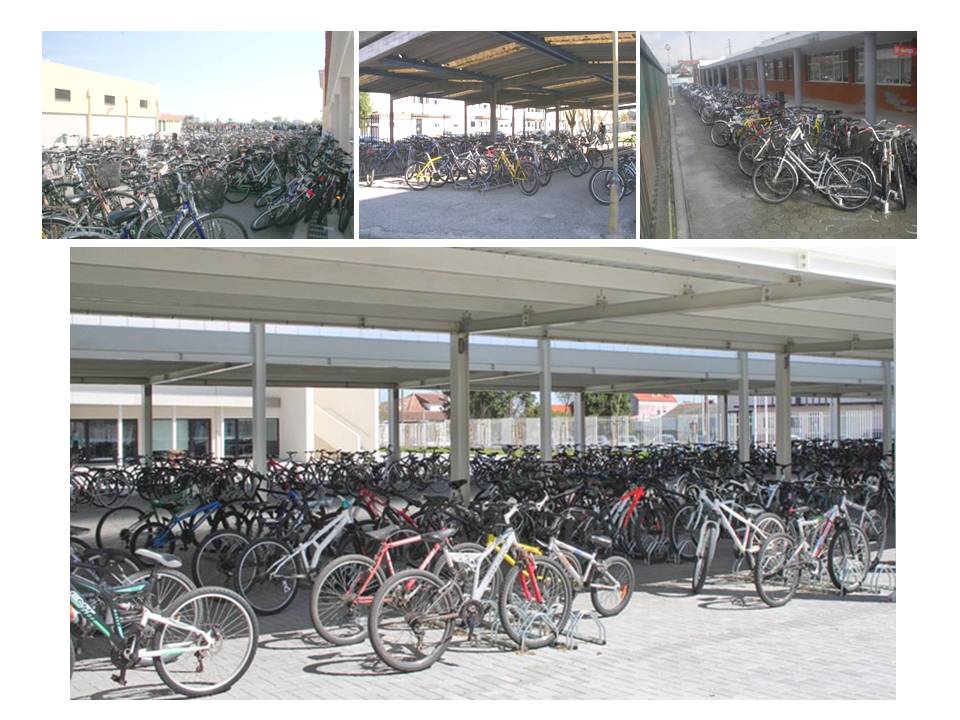
Bicycle mode share in the Aveiro region ranges from 10 to 17%, well above current European or national averages. With local policy and advocacy focused as it is in Aveiro, and with numbers expected to grow even further as the university's role, strong persistant local advocacy, and focused policy kicks-in; sooner or later, Aveiro will become an important player in Portugal's, and possibly Europe's bicycle scene.
U-Bike, Portugal's University Bike Lending programme
One of Aveiro's most recent contributions towards defining a nationwide bicycle policy is its involvement in Portugal’s U-Bike university bike lending programme; 15 universities all over the country are participating in this €6.4 million program, reducing energy consumption and carbon emissions from car-use, as part of Portugal's Climate Action Plan. A total of 3,300 conventional and electrically assisted bicycles will be lent to students as part of a program to change mobility habits amongst university students and staff, aiming at achieving 5% bicycle mode-share nationally by 2020.
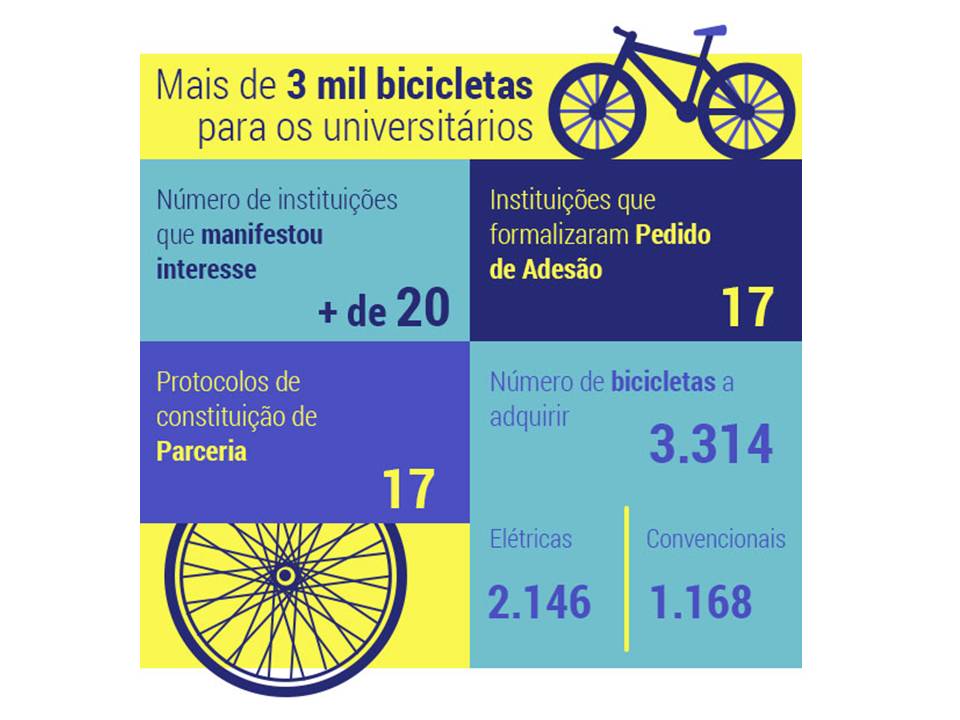
The University of Aveiro, which already registers higher bicycle mode share values than others, will provide 239 bicycles to students and staff, and has already doubled bike parking from 300 to 600 racks, and is installing two new covered bicycle parking shelters on campus.
Cycling Explodes in Lisbon
But despite Aveiro's leadership in thinking how to reintroduce bicycle mobility into the country’s mainstream, it is the city of Lisbon that is realizing the most ambitious and courageous action plan for urban cycling. This year's European Mobility Week saw mayor Fernando Medina and his councillor for bicycle policy, José Sá Fernandes, announce an impressive bikeway network expansion in Portugal's largest city. The aim is to reach 210km by next summer in a primary and secondary grid throughout the entire city, with projects and construction already well underway throughout the city. And the push doesn't stop there. 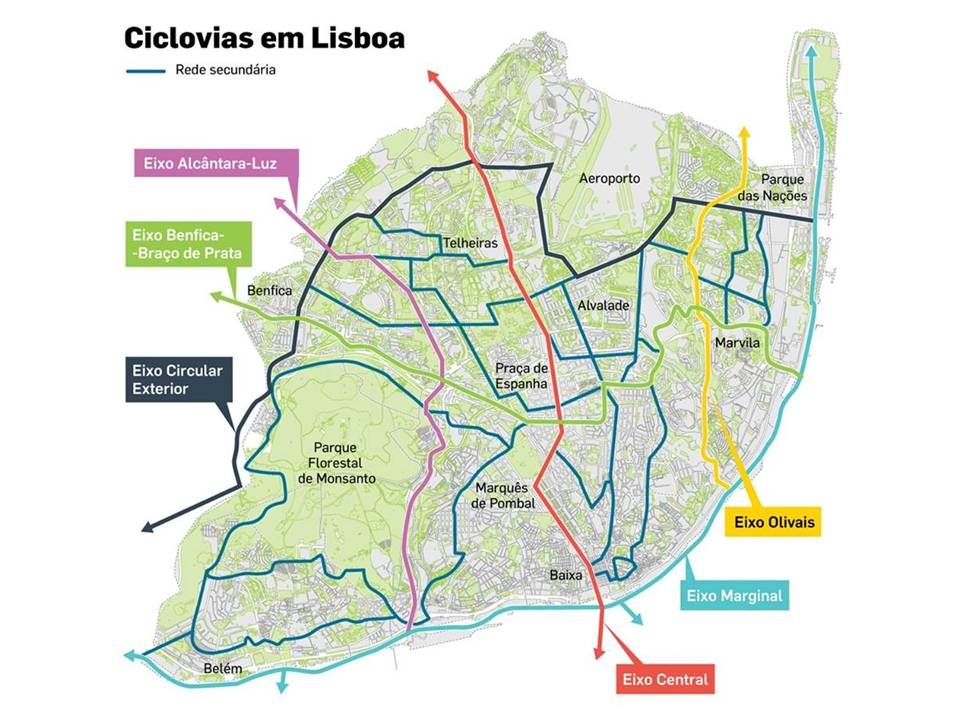
Many of the new bikeways along the capital city's major avenues and the principal central artery, where construction began last May, should be ready in a few months. Bicycle parking provisions are also underway all over the city, and most significantly, a state-of-the-art 4th generation bikeshare system – integrated into the public transport system - has been awarded to Portuguese manufacturer Orbita, starting with 1,410 bicycles and 140 docking stations in Lisbon's uptown, downtown and riverside neighbourhoods.
By 2018 Lisbon should be enjoying a relatively dense pattern, covering the entire city and 10 bikeway connections to the neighbouring municipalities. The idea is to lower car travel considerably, not only inside the city, but also from the suburbs into the urban core. Suburban traffic currently accounts for 2/3 of all cars travelling in Lisbon municipality on normal weekdays. New connections are being prepared to access the heavily car-dependant municipalities of Oeiras, Amadora, Odivelas and Loures, to the three ferry terminals serving municipalities south of the Tagus River: Almada, Seixal, Barreiro and Montijo, and to public transport hubs connecting to the entire metropolitan area and outlying region (train and subway stations, and regional bus interfaces), plus the two international rail stations, the airport, and cruise-ship terminals.
Projects, preceded by intense public and political discussions, and media coverage, were conducted over the last three years, with construction in the city starting last Spring on several greenways to serve as shortcuts, but especially on over 160 avenues and streets in the heart of the built-up areas, 32 important city squares and the city's most important central artery. These major transformations are also to be completed by 2020, and most are already well underway, such as the riverside square in front of Cais do Sodré commuter train station and ferry terminal. A significant part of the work is planned for completion before the Spring of 2017, in line with the launch of the public bikeshare system.
Some of the projects were programmed as part of the neighbourhood regeneration designed to reclaim public squares back into neighbourhood life, while other major urban interventions were also being developed to follow-up on the winning public participatory budget proposals for more and better bicycle infrastructure, such as the bike ramps on stairs to hilly areas (winning proposal in 2013), and the bike paths connecting the various University of Lisbon faculties and campus areas, spread out around the city, or the proposal for a bicycle path on some of the city’s major arteries connecting the uptown to downtown areas (winning proposals in 2014). Funding has also been resourced from the city's need to repave 110km of its street network. In total the city is investing €42 million over the next years, dedicated to improving bicycle accessibilities.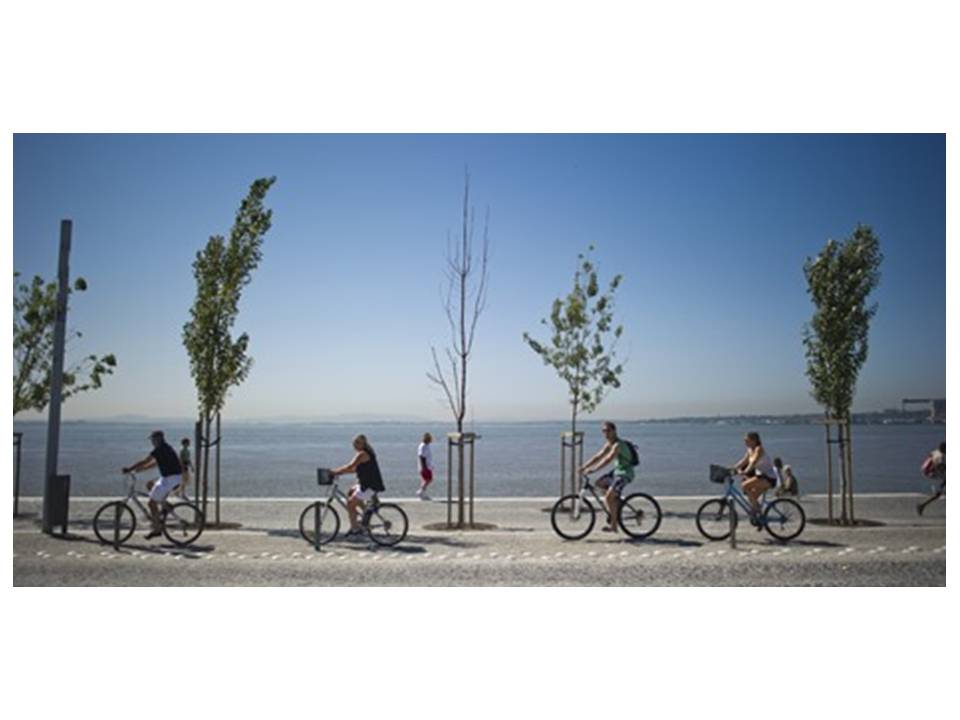
Three Lisbon universities will realize the U-Bike bicycle lending program, introducing an extra 440 bicycle for daily use in the city. Together with the new bikeshare scheme, an increase of at least an extra 6,500 bicycle trips are expected in the city on a daily basis, helping to increase city cycling’s visibility and role in mode shift.
Moving counts performed upon two of Lisbon’s main corridors show that since 2009, when the 8km riverside bikeway was inaugurated, bicycle use has increased almost 10 times in the city, and gender split has risen from 0% to 28%. By the Summer of 2017 Lisbon's mode-shift to active mobility should be experiencing an even stronger boost, as public space will gradually be reallocated to pedestrians and cyclists, complemented by a thorough update in the public transport network which includes the new bikeshare system, but also the transition of the bus/tram/subway operator from the central government to Lisbon Municipality, introducing 250 new buses, 7 new express routes, and 21 new local routes, and tariffs focused on greater use by children and seniors. This overall effort to reduce car-use and reinforce the city's commitments to decarbonisation, lower noise levels, and better air quality should provide even further competitiveness to bicycle use, especially in the city’s denser, central neighbourhoods.
Lisbon's suburbs slowly wake-up...
With 2 out of 3 cars originating from the outlying suburbs, Lisbon's new mobility paradigm should show signs of influence upon policy in the outlying metropolitan area. In most cases, urban sprawl and lack of political will power have traditionally hindered sustainable mobility options in Lisbon’s neighbouring municipalities. Now however, even some of the most car-dependant suburban areas are showing signs of change, finally starting to address the need for a more sustainable mobility paradigm, with measures promoting bicycle mobility and expanding local bikeway networks.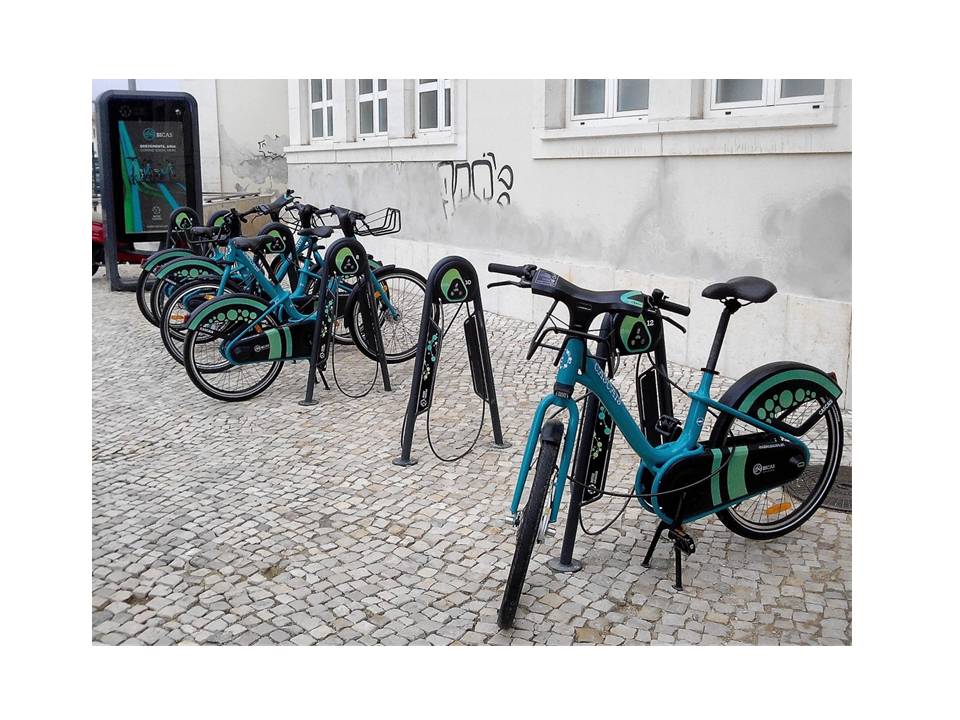
Barreiro, a quick ferry ride across the Tagus river from Lisbon, has one of the most ambitious strategies to increase bicycle use, recently announcing 108km of new bikeways, to be implemented within all of its urban areas and major points of interest, in a tight grid network.
Also on the South side of the Tagus river, various municipalities have jointly approved a €12 million plan to implement an integrated bikeway network connecting major urban areas, accessibilities to public transport (bus, tram, rail and ferry), and the area's beautiful natural areas and coastal beaches.
Vila Franca de Xira and Loures, two municipalities North of Lisbon, are currently planning a 20km bikeway connecting along the northbank of the Tagus River right into Lisbon's Parque das Nações neighbourhood and connecting with the city's expanding bikeway network. Loures recently launched the construction of a 2.6km bikeway connecting three important neighbourhoods; Sacavém, Portela and Moscavide. This bikeway will provide an alternative to existing car-focused roadways, passing over two motorways and connecting densely populated residential areas to schools, public facilities, street shopping areas, a subway station, and Lisbon's comprehensive bikeway network.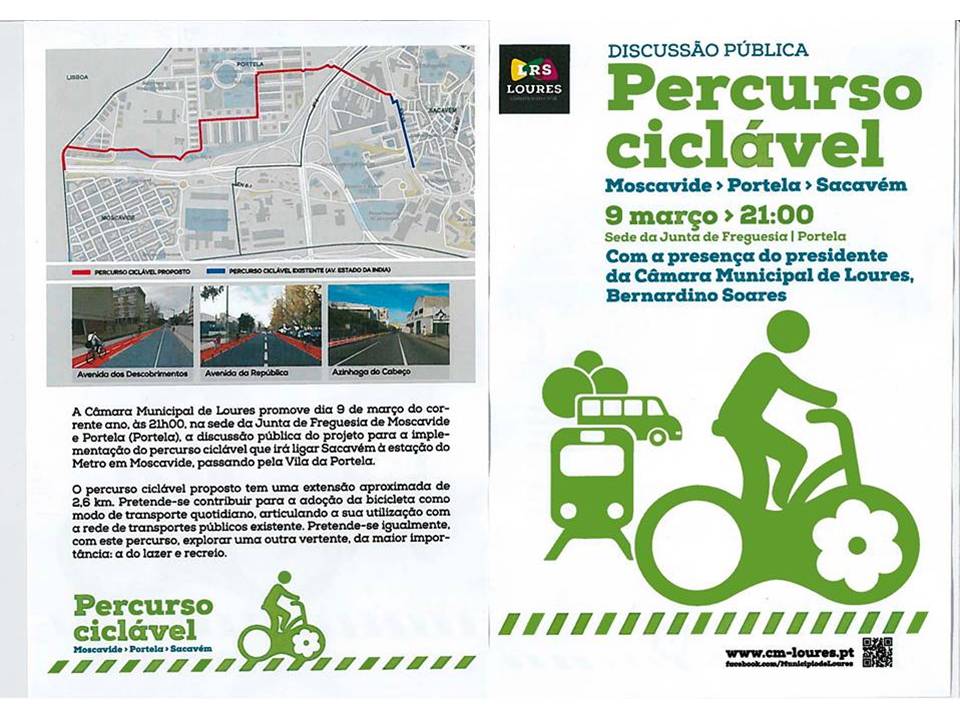
Sintra, recently inaugurated its first 2.8km bikeway this year, and announced plans to build a basic €5million 39 km of bikeway network by 2019, including a greenway connection to neighbouring Amadora and Oeiras municipalities. For now the focus is on some of the denser urban areas, connecting these to local public facilities and important train/bus stations, in one of the most heavily populated suburban areas in the greater Lisbon area.
Cascais, an important town West of Lisbon, is planning to triple its bikeway network, and has already started upgrading its 45 bicycle, 3 station first generation leisure oriented bike-share scheme into a 1,200 bicycle, 2,000 dock mobility focused bike-share programme. Besides implementing new bikeshare stations, Cascais inaugurated over 5km of new bike paths earlier this year, and is planning to connect its 5 densest urban areas to its existing bikeway network and to the neighbouring municipality of Oeiras before the end of 2018.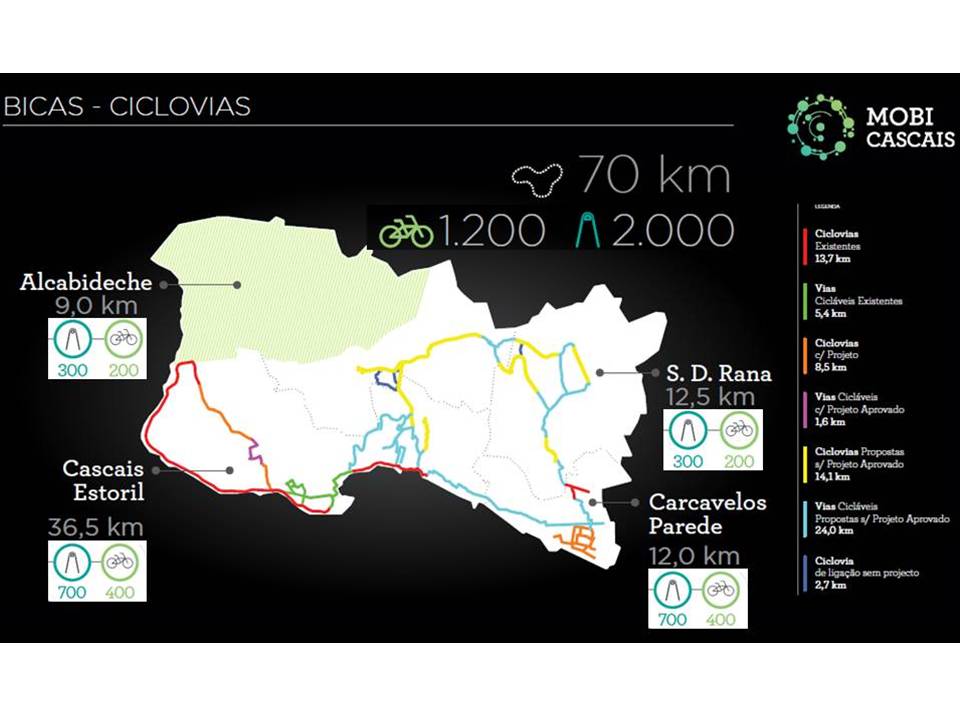
Algarve Bicycle Destination
Portugal’s Algarve region is one of Europe's sunniest beach and golf locations, and also one of its most sought bicycle destinations. Bicycle mode-share is above average for Portugal, and the Algarve has been at the forefront of Portugal's cycle tourism effort since the start. The implementation of EuroVelo 1 - The Atlantic Coast Route in Portugal covered 220km of Algarve’s South coast, and as of this Summer, the route covers 920km of Portugal’s coastline, all the way to the Northern border with Galiza.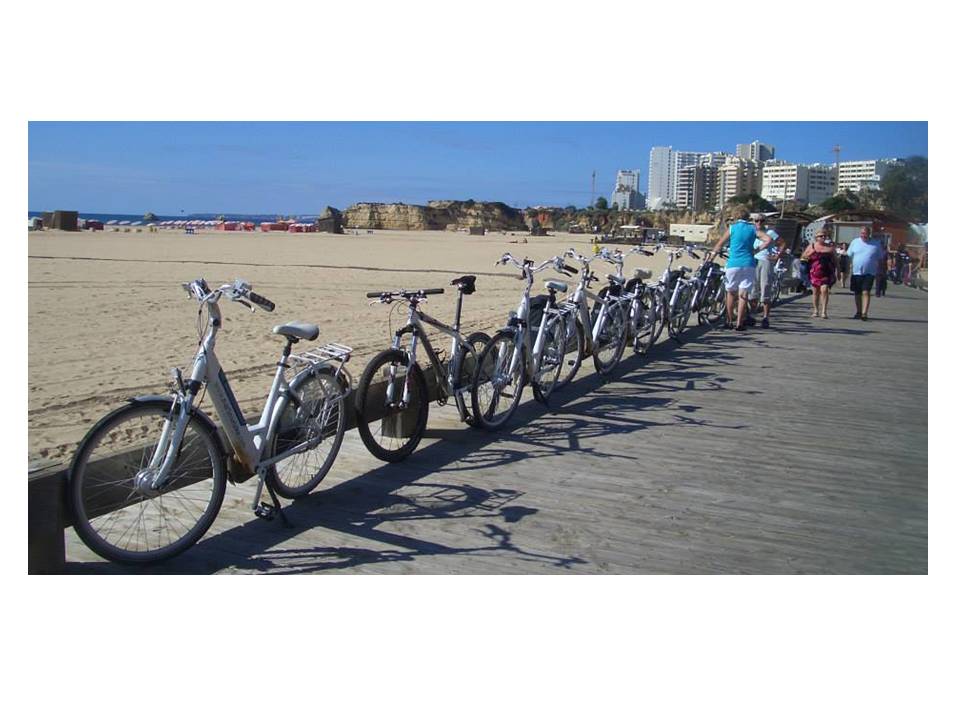
Algarve's municipalities have taken the lead in various hard & soft measures nationally, such as the Vilamoura resort’s large-scale bikeshare scheme and bikeway network, or Loulé's school bikeshare and bicycle parking program.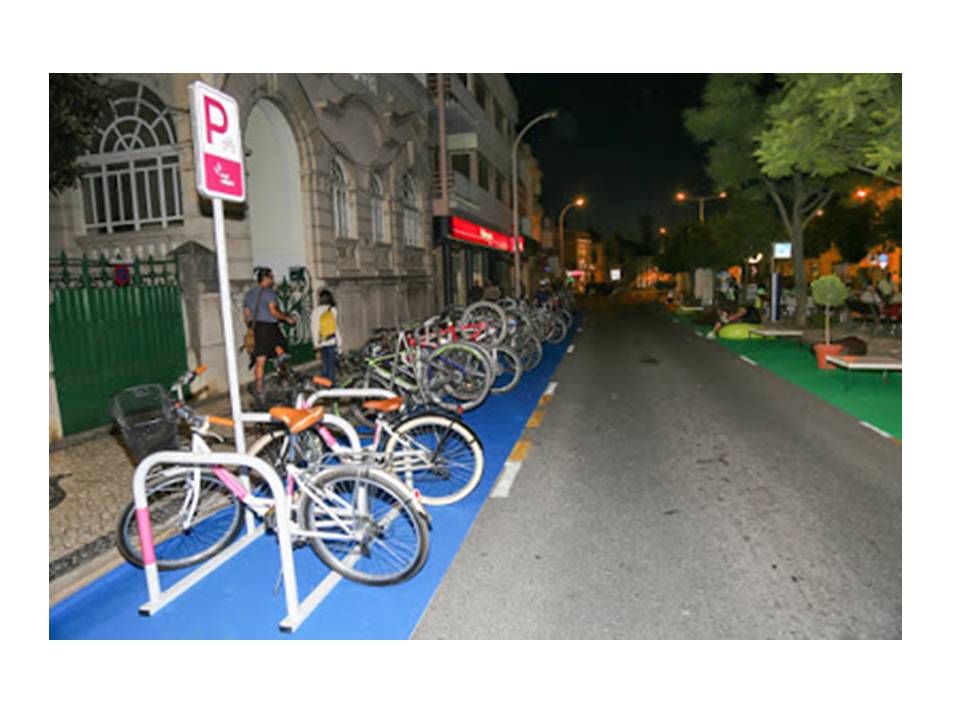
Benchmark Municipalities
Major infrastructure improvements are underway in a number of Portuguese municipalities at the moment, funded by Portugal 2020 and aligned with the urban sustainable mobility plans, especially in those areas where the Eurovelo 1 Atlantic Coast route’s 700km expansion was recently approved along mainland Portugal's west coast, or in cities and towns where political will has been strongest. The greatest effort is clearly in Lisbon, but on a proportionate basis, municipalities such as Braga, Maia, Murtosa, Ilhavo, Peniche, Torres Vedras, Cascais, Barreiro, Seixal, Elvas, Evora, Sines, Loulé, São Bras de Alportel, and Vila Real de Santo António are also implementing important bicycle infrastructure, supporting measures and programs.
Back to cycling?! Cycling forward!
Once these important municipalities fully implement what they're doing, Portugal may reconsider cycling as one of its most important modes of transport. Just as the culture was there in the first half of the 20th century, now it can take shape looking to the future. When this starts to happen, no doubt that Portugal will show strong signs of becoming one of Europe's next cycling nations, and hopefully other municipalities and larger segments of the population will follow suit, providing a multiplier effect to bicycle use in the country, and to healthier, more sustainable mobility habits.
Regions:
News category:
Network/Project Involved:
Contact the author
Recent news!
Upcoming events
Contact Us
Avenue des Arts, 7-8
Postal address: Rue de la Charité, 22
1210 Brussels, Belgium









